In the early 1970s, the Dutch Navy decided to build a new class of 12 frigates to meet the fleet’s requirement of 18 anti-submarine frigates. The standard frigate design was chosen to meet this requirement. Construction began in 1975 and ended in 1982 with the delivery of the twelfth and final frigate of the class.
The class is known as the “S” class or Kortenaer after the name of the first frigate delivered to the Dutch Navy in 1978. On 15 September 1980 and 7 June 1981, it was ordered by the Greek company PN. A total of two frigates, the F450 Elli and the F451 Limnos. These were the sixth and seventh respectively direct builds through the Dutch Navy programme.
Later, the Dutch Navy covered the shortage of these two ships by building an anti-aircraft version also known as “L” frigates. The main change was the removal of the helicopter hangar and helipad and the installation of a Mk13 GMLS launcher for RIM-66 SM-1 medium-range anti-aircraft missiles and the Goalkeeper anti-missile system in the stern.

The fall of the Soviet Union and the breakup of the Warsaw Pact in 1990 led to major changes in the weapons system ceilings of many Western European countries and NATO members. This led to the gradual withdrawal of all “S” class frigates from the ranks of the Dutch Navy in the 1990s. Having received very good impressions from the use of Elli and Lemnos but also his great needs to retire the old American destroyers FRAMM and CFADAMS as well as the KNOX frigates, he seized the opportunity and within a decade was able to put into Greek service eight more units of Greek service. The type that was retired at that time.


the design
The hull design of the “S” frigates was derived from the earlier Van Speijk class which in turn was derived from the British Leander class frigates. This choice was made with the main consideration being the very good ship characteristics of these frigates in sinking conditions. The main feature of the boat is the fine lines of the hull. The hull features a waterline and ultra-thin section curve at the front and rear providing less drag. The stern transom features a small draft. The bow features a low opening on the sides and a medium-height boom, and also has a bow bulb where the sonar is mounted.
The main dimensions of the vessel are overall length of 130.5 metres, waterline length of 121.8 metres, waterline width of 14.4 metres, and average draft of 4.27 metres. The depth of the hollow is 9 metres, and the average height of each surface is 2.7 metres. Finally, the ship displaces 3,630 tons fully loaded and 2,767 tons empty. The hull and superstructure are made of steel. The structural strength of the hull is longitudinal and consists of longitudinal reinforcements, “T” type beams placed every 0.50 metres, and transverse reinforcements (mesh frames) placed every 1.4 metres.
Accordingly, the structural strength of the superstructure is incidental and is not included in the overall structural strength of the ship. The superstructure consists of three separate blocks. The bridge block including the radar mast with all electronics has three decks extending from the main deck to the ship’s bridge, the block containing the chimney and air intakes for the ship’s main engines in the center and the aft helicopter hangar block including the long wing. Range search radar. Accordingly, the structure is divided into 15 watertight compartments and three floors. The ship’s survivability after a hit or breach was calculated to be able to withstand flooding by seawater for three consecutive compartments.
The ship has a capacity of 200 people and, in accordance with the practice in the Dutch service, can carry out missions even with a crew of only 165 officers, non-commissioned officers and sailors. The accommodation is divided as follows: officers stay in a one- or two-person cabin, petty officers in a one-, two-, or four-person cabin, and sailors in a six- or twelve-person cabin.
The ship’s main engine and electromechanical equipment compartments are located amidships and occupy a length equivalent to about one third of the total length of the ship. From bow to stern, these compartments are: 1) Instrumentation compartment for the ventilation/ventilation system, 2) Forward compartment for generator pairs, 3) Engine room No. 1 with main wind turbine, 4) Engine room No. 2 with sail wind turbine where it includes reducers The ship’s speed and active stability systems and 5) the aft compartment for the generator pairs. Large openings on the second and third decks help allow major machinery to be removed from the ship for repair or maintenance ashore.


The ship’s main propulsion system is a combination of high-speed or COGOG (combined gas or gas) turbines driving two shafts that drive five-blade 5C14 variable pitch propellers from acb LIPS now owned by Wartsila. The power plant consists of two Rolls-Royce Olympus TM3B marine turbines with an output of 19,240 kW at 3,600 rpm each to achieve high speeds to drive the shafts through reduction gears. For lower speeds, two Tyne RM-1C turbines, also from Rolls-Royce, rated at 3,690 kW at 14,500 rpm each, are used, which drive the shafts via speed reducers. The power unit has one gearbox per axle, manufactured by Damen Schelde. The vessel achieves a top speed of over 30 knots with Olympus turboprop operation. With the Tyne RM-1C, the vessel achieves 20 knots while its economic speed is 16 knots and has a range of 4,600 nautical miles. The maximum speed of 30 knots is achieved when the ship is at full load while the maximum range (endurance) is calculated when the fuel tanks are at half capacity. The ship is steered by a single rudder while the ship’s stability in the transverse plane is supported by parachutes and a Denny-Brown active stabilization fin system mounted on both sides.


Electrical requirements are met by four SEMT-Pielstic PA4 diesel generators rated at 750 kW at 1,200 rpm each. The ship’s electrical power needs are fully covered by two running generators. The generators are installed in pairs, two in the bow compartment and the other two in the aft compartment. This arrangement ensures that the vessel always has 100% electrical power since there are two watertight compartments between them. On the frigates HELLI, LImnos and ADRIAS, the generator pairs have been replaced with newer technologies, with the generous sponsorship of the Aikaterini Laskaridis Foundation, through the KYKNOS II programme. All of the ship’s main machinery and networks are controlled by van Rietschoten & Houwens’ machinery control room, which is located on the second deck above the bow of the generator pair cabin.
shield
The frigate’s main armament consists of a single Compatto 76 gun in the bow. A second gun was mounted on the original frigates above the helicopter hangar, which was held by the Greek frigates F/G Elli and F/G Lemnos, and later replaced in Dutch service by the CIWS Goalkeeper system. Accordingly, the CIWS Mk15 Phalanx system was installed in Greek service. On F/G Elli and F/G Lemnos, due to the presence of the gun, two CIWS Mk15 Phalanx battalions were mounted on either side of the hangar, covering an almost 360 degree arc. Air defense is covered by eight Mk29 Mod1 launchers for RIM-7P NSSM anti-aircraft missiles. The ship can carry up to 24 A/V missiles that are manually loaded onto the launch pad. To attack surface targets, the ship carries two quad MK141 launchers for AGM-84D/G Harpoon missiles mounted on the mid-deck. It also has twin MK32 Mod9 torpedo tubes for the Mk46 Mod5 torpedoes. Up to 16 torpedoes could be carried in the torpedo compartment. As the last line of defense against incoming missiles outside the CIWS, it has four SRBOC launchers made up of six decoys mounted on each side of the ship. For anti-submarine warfare, the ships carry an AB-212ASW or S-70 AegeanHawk A/V helicopter. The hangar can accommodate two AB-212ASW helicopters or one S-70 AegeanHawk helicopter. With the entry into service of the S-70 AegeanHawk helicopters, the frigates’ airstrip has been structurally strengthened to be able to withstand the increased weight of these helicopters.
Electronic equipment
The main scanning radar is the 2D LW08 which transmits in the L band. It has a range of 260 km and is capable of tracking 400 targets. For surface scanning, the ZW06 radar is used. The ZW06 transmits in the 7P and controlling the fire of the two guns against surface targets through the three weapons control channels. As for the A/V weapons, the ships are equipped with SQS-505 or SQS-509 sonar mounted in the bow lamp on newer Canadian Westinghouse ships with a maximum target detection range of about 29 km. In the electronic warfare arm, the ships have Elettronica’s SPHINX ESM system and Elettronica’s SLQ-01 ECM system on former Dutch ships. Many of the above electronic systems on six of the nine frigates in service were replaced or upgraded during the upgrade program.
Upgrade program for “S” frigates in Greek service
In February 2003, a contract for the upgrade of 6 standard frigates was signed with Thales in the amount of €381,575,580 million and was implemented at the Scaramangas shipyards between the years 2004-2009. The core of the program was the installation of the modern combat management system TACTICOS, which was installed in all units of that time, S-VITA, HSY-56A, Combattante II, the replacement of specific electronic systems and the complete restoration of mechanical equipment. At the end of the program, 6 ships received the following systems:
- Installation of MIRADOR E/O monitoring and fire control system.
- Replacement of the old ZW06 surface radar with the modern SCOUT Mk2 LPI radar.
- Upgraded WM25 fire control and surface radar.
- Upgraded long range 2D airborne radar LW08.
- Replacing the old SEWACO II battle management system with the newer TACTICOS system of the same company.
- Replaced SPHINX PC system with EDO CS-3701 (ESM).
- Install ALEX cheat system.
- Installation (on three ships) of the INMARSAT FLEET 77 system.
- Add a GPS receiver.
- Replacement of integrated communications system.
- STIR tracking and illumination radar upgrade 1.8.
- Installation of two Marine Inertial Systems (INS) Mk39 Mod3A Ring Laser Gyro to replace the Mk29 and Mk23 gyroscopic compasses.
- Link 11 data link system upgrade.
The ships that received the above-mentioned update are: F/G HELLI, F/G LIMNOS, F/G ADRIAS, F/G AEGAION, F/G NAVARINON and F/G KOUTOURIOTIS.

“Avid problem solver. Extreme social media junkie. Beer buff. Coffee guru. Internet geek. Travel ninja.”





More Stories
“Recycling – Changing the water heater”: the possibility of paying the financing to the institution once or partially
Libya: US General Meets Haftar Amid Tensions Between Governments
New tax exemption package and incentives for business and corporate mergers..